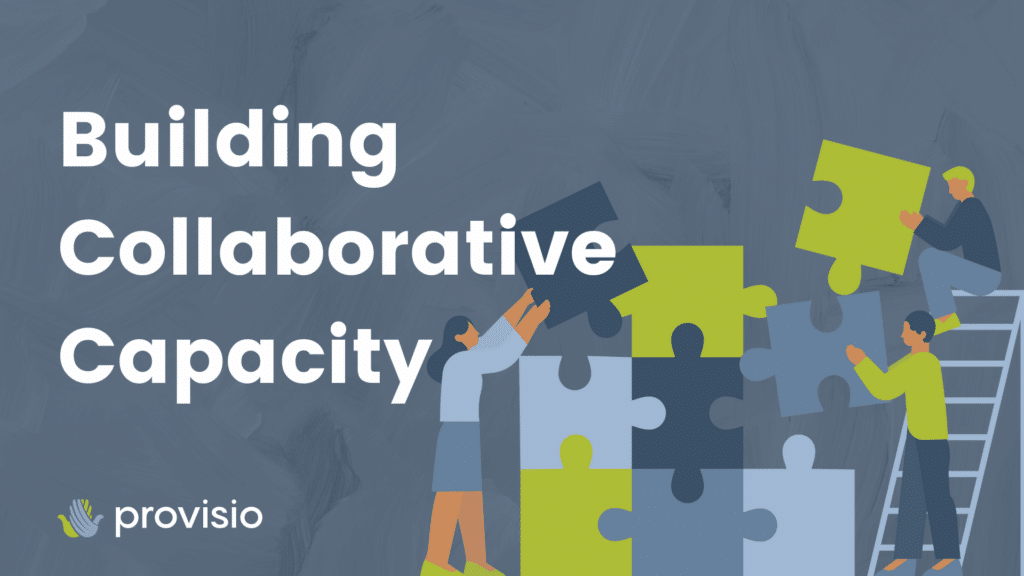Collaboration is a nice idea—but not “a given.” And in the nonprofit, public, and philanthropic sectors, the ability to collaborate is not born, but built—through coaching, patience, and shifting one’s natural tendencies to control. Similarly, it is falsely assumed that, just because more than one social sector actor wishes to work alongside and in true cooperation with others, that an innate set of skills and experiences will kick into gear to make this possible.
Provisio’s Advisory Services team is exploring how to effectively collaborate at the organizational level to achieve a similar societal vision. We are questioning the ways organizations (not just nonprofits but also foundations, government agencies, corporations, media, etc.) can fully leverage their entire tool belts—especially their partnerships—to become sustainable and meet the challenges of the current moment. To do so requires re-envisioning our idea of HOW to work collaboratively. It also demands we support and invest in an organization’s leadership and institution-wide capacity to effectively build and leverage relationships, especially those engaged in network or coalition building.
Provisio is proposing a name and definition for this proficiency: Collaborative Capacity—otherwise defined as an organization’s ability to a) understand its positioning within its ecosystem; and b) build and activate relationships with others in and across sectors.
To assist organizations in assessing and building their collaborative capacity, we have identified eight areas critical for organizations looking to partner more effectively with others in their community:
| Subcapacity Area | A Social Sector actor with this Subcapacity is an organization … |
| Ecosystem Analysis: Analyzing and understanding one’s social sector ecosystem, including knowledge of all key actors (nonprofits, government agencies, funders, businesses, media, civic/religious groups, community leaders, clients/constituents, etc.), and dynamics that shape relationships amongst them. |
|
| Organizational Awareness: An organization’s ability to recognize its unique role and value within an ecosystem based on its distinct organizational and programmatic assets and resources. |
|
| Relational Skills: Leadership skills needed to build and maintain relationships with others, including engaging stakeholders, knowing when and how to cede control, addressing power dynamics, and building trust relationships. |
|
| Relational Culture: Leadership fostering an organizational culture that values and seeks out collaborative opportunities. |
|
| Cultural Competency: An organization’s ability to understand and appropriately respond to the existing and changing cultural variables of others, including ability, age, beliefs, ethnicity, experience, gender, gender identity, linguistic background, national origin, race, religion, sexual orientation, and socioeconomic status. |
|
| Program Strategy Alignment: An organization’s ability to set shared programmatic goals and coordinate strategies with other social sector actors. |
|
| Collaborative Infrastructure: The organizational structures and systems required for effective collaboration, including the management and coordination of personnel, technology, knowledge, and resources. |
|
| Outcomes Analysis: The ability and commitment to evaluate the impact of, learn from, and continuously improve collaborative relationships. |
|
Social Sector actors that have strengthened each of the above areas will be better equipped to engage in more complex collaborative efforts to achieve increased impact with partners.
At Provisio, we harness the power of information and knowledge towards greater social impact. We do this by guiding nonprofit, public, and philanthropic sector organizations at every stage of their innovation journeys – from mission planning to technical execution to ongoing proactive execution support. Only by building and nurturing collaborative capacity will we be able to achieve our individual and collective goals.

Julie is a transformational leader and change agent distinguished in her ability to connect complex ideas with seemingly unrelated parts and order them in ways that help a wide range of stakeholders with diverse goals get on the same page. Her field-tested expertise in community partnership-building, youth development, education, network and coalition strengthening, cultural policy, and gender and health equity has helped numerous organizations develop and implement strategic plans, design new business models, and evaluate programs.

